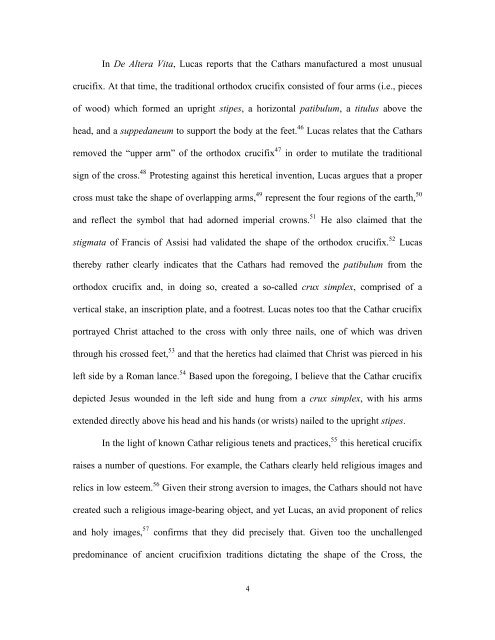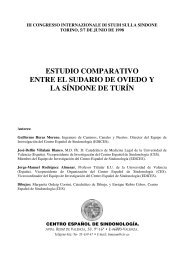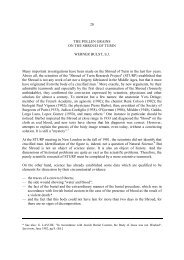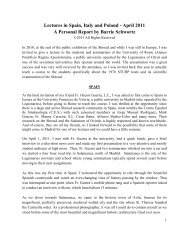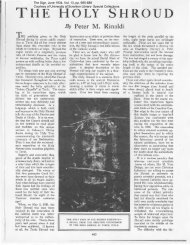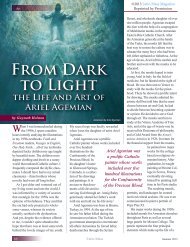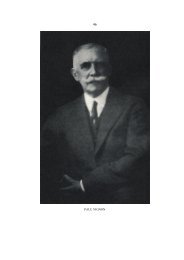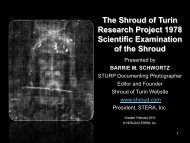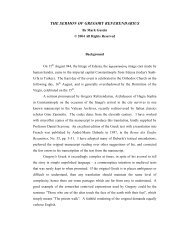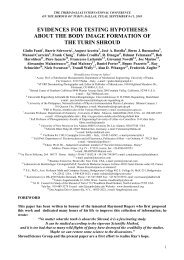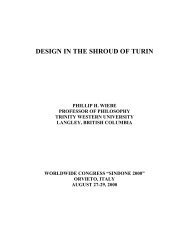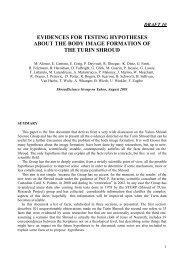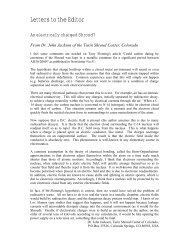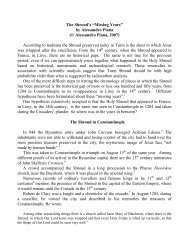the cathar crucifix - The Shroud of Turin
the cathar crucifix - The Shroud of Turin
the cathar crucifix - The Shroud of Turin
Create successful ePaper yourself
Turn your PDF publications into a flip-book with our unique Google optimized e-Paper software.
In De Altera Vita, Lucas reports that <strong>the</strong> Cathars manufactured a most unusual<br />
<strong>crucifix</strong>. At that time, <strong>the</strong> traditional orthodox <strong>crucifix</strong> consisted <strong>of</strong> four arms (i.e., pieces<br />
<strong>of</strong> wood) which formed an upright stipes, a horizontal patibulum, a titulus above <strong>the</strong><br />
head, and a suppedaneum to support <strong>the</strong> body at <strong>the</strong> feet. 46 Lucas relates that <strong>the</strong> Cathars<br />
removed <strong>the</strong> “upper arm” <strong>of</strong> <strong>the</strong> orthodox <strong>crucifix</strong> 47 in order to mutilate <strong>the</strong> traditional<br />
sign <strong>of</strong> <strong>the</strong> cross. 48 Protesting against this heretical invention, Lucas argues that a proper<br />
cross must take <strong>the</strong> shape <strong>of</strong> overlapping arms, 49 represent <strong>the</strong> four regions <strong>of</strong> <strong>the</strong> earth, 50<br />
and reflect <strong>the</strong> symbol that had adorned imperial crowns. 51 He also claimed that <strong>the</strong><br />
stigmata <strong>of</strong> Francis <strong>of</strong> Assisi had validated <strong>the</strong> shape <strong>of</strong> <strong>the</strong> orthodox <strong>crucifix</strong>. 52 Lucas<br />
<strong>the</strong>reby ra<strong>the</strong>r clearly indicates that <strong>the</strong> Cathars had removed <strong>the</strong> patibulum from <strong>the</strong><br />
orthodox <strong>crucifix</strong> and, in doing so, created a so-called crux simplex, comprised <strong>of</strong> a<br />
vertical stake, an inscription plate, and a footrest. Lucas notes too that <strong>the</strong> Cathar <strong>crucifix</strong><br />
portrayed Christ attached to <strong>the</strong> cross with only three nails, one <strong>of</strong> which was driven<br />
through his crossed feet, 53 and that <strong>the</strong> heretics had claimed that Christ was pierced in his<br />
left side by a Roman lance. 54 Based upon <strong>the</strong> foregoing, I believe that <strong>the</strong> Cathar <strong>crucifix</strong><br />
depicted Jesus wounded in <strong>the</strong> left side and hung from a crux simplex, with his arms<br />
extended directly above his head and his hands (or wrists) nailed to <strong>the</strong> upright stipes.<br />
In <strong>the</strong> light <strong>of</strong> known Cathar religious tenets and practices, 55 this heretical <strong>crucifix</strong><br />
raises a number <strong>of</strong> questions. For example, <strong>the</strong> Cathars clearly held religious images and<br />
relics in low esteem. 56 Given <strong>the</strong>ir strong aversion to images, <strong>the</strong> Cathars should not have<br />
created such a religious image-bearing object, and yet Lucas, an avid proponent <strong>of</strong> relics<br />
and holy images, 57 confirms that <strong>the</strong>y did precisely that. Given too <strong>the</strong> unchallenged<br />
predominance <strong>of</strong> ancient <strong>crucifix</strong>ion traditions dictating <strong>the</strong> shape <strong>of</strong> <strong>the</strong> Cross, <strong>the</strong><br />
4


